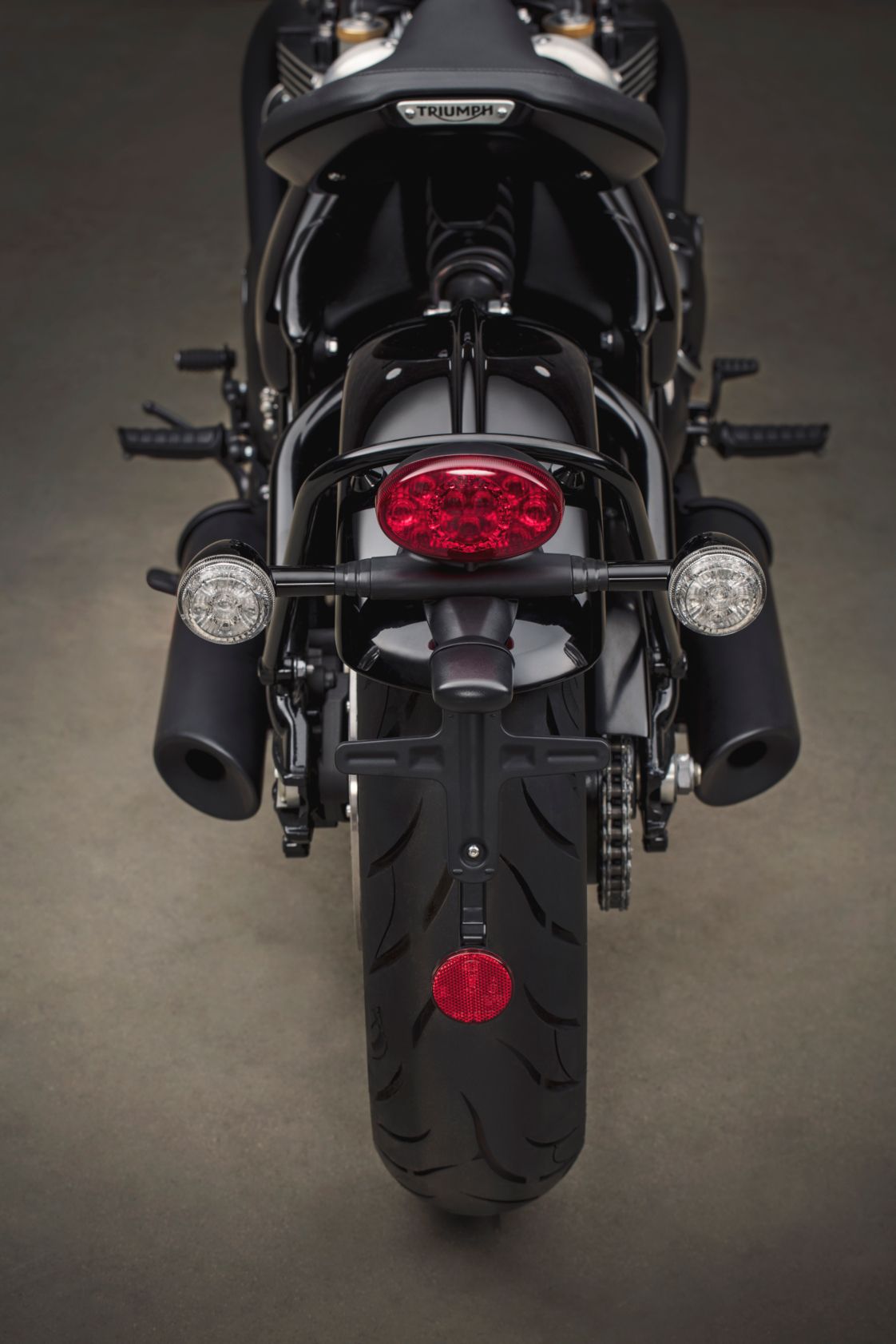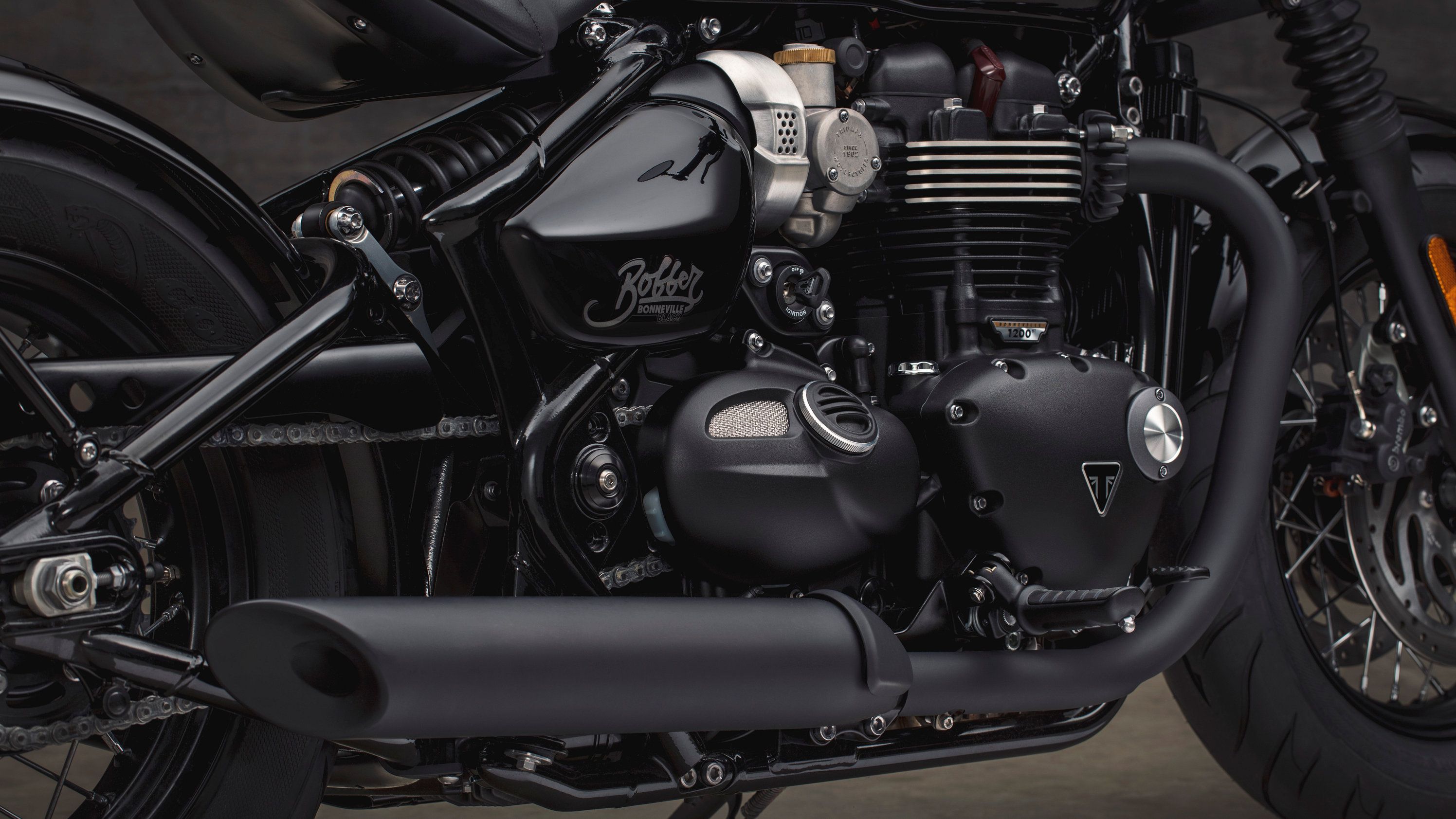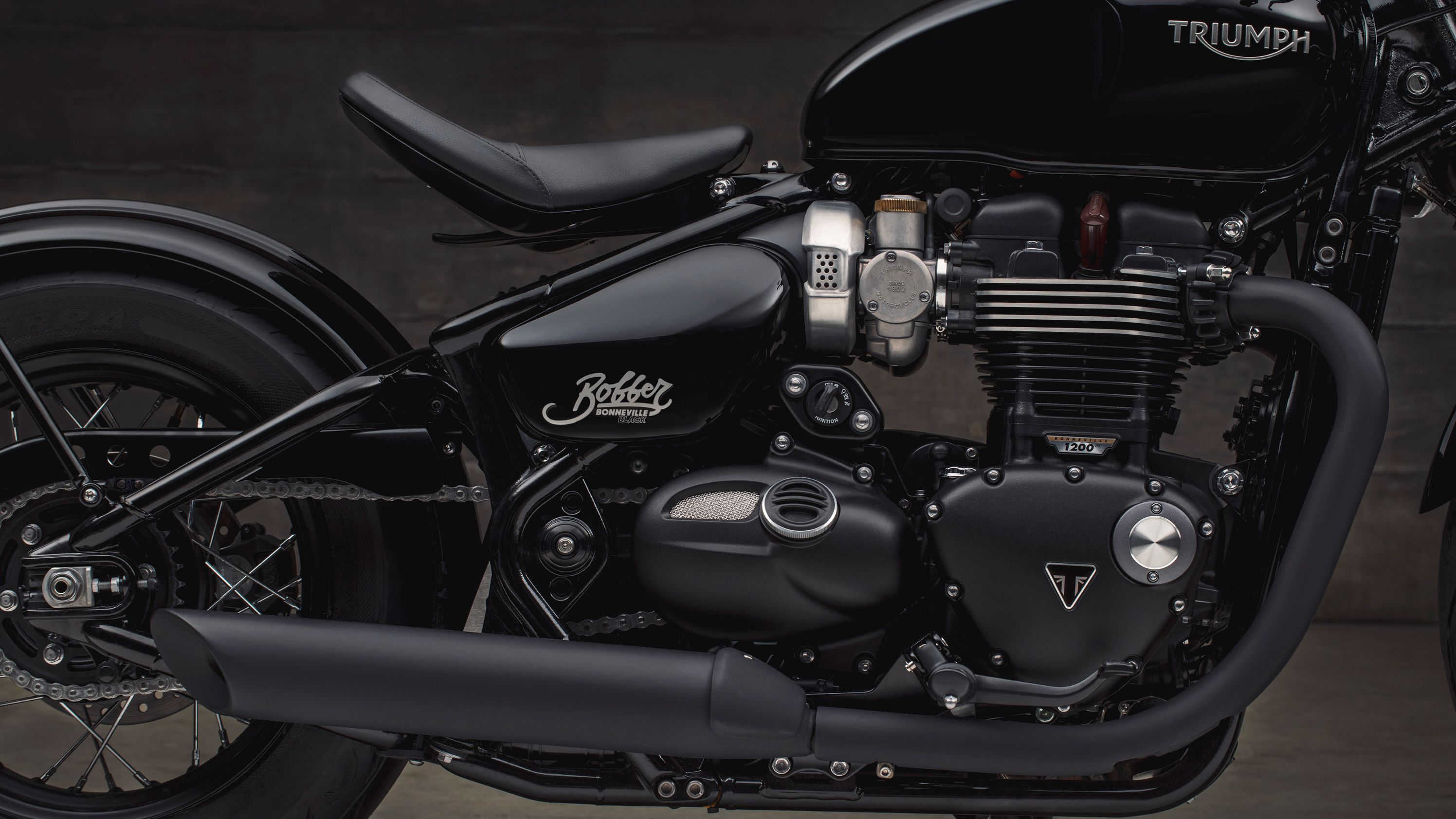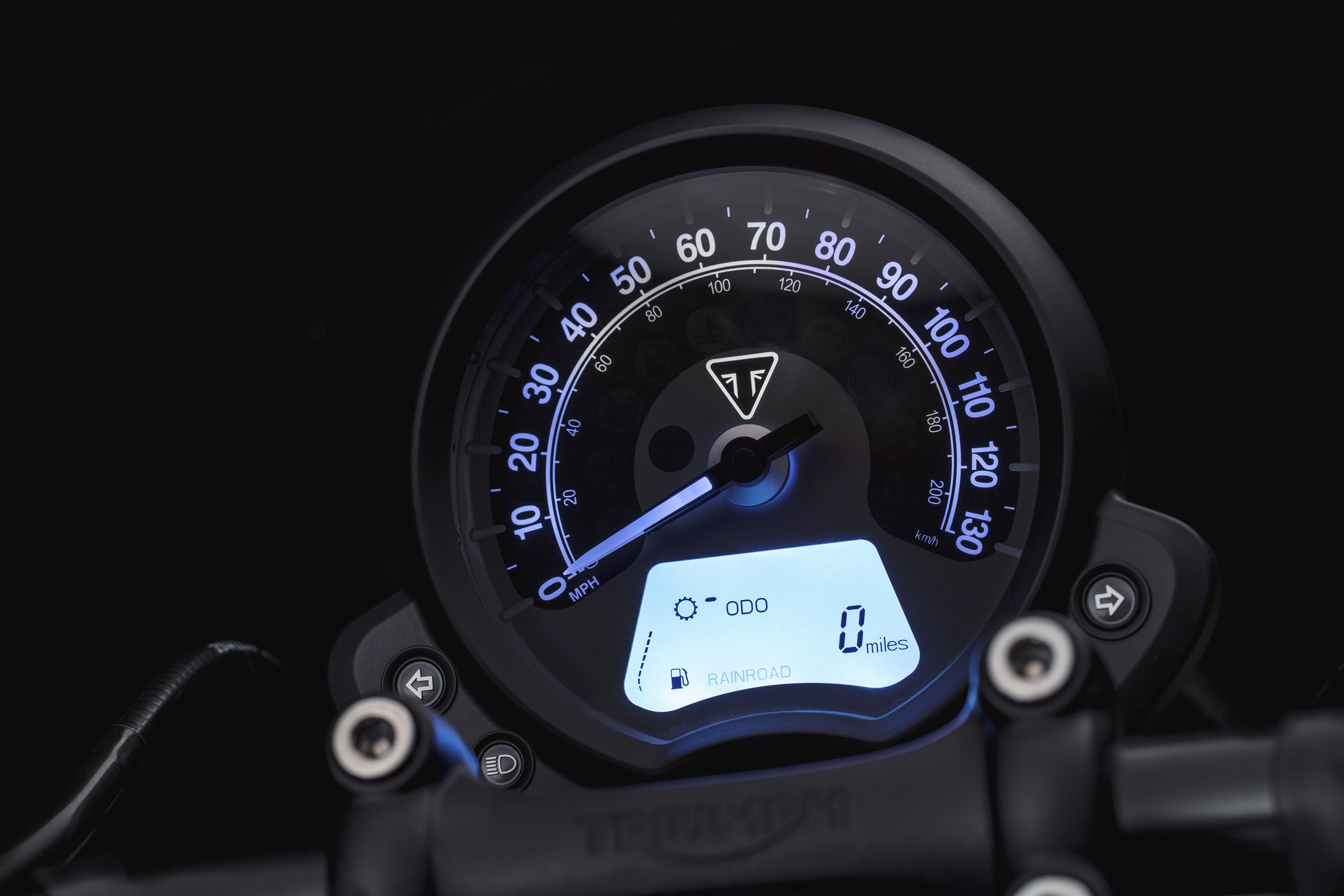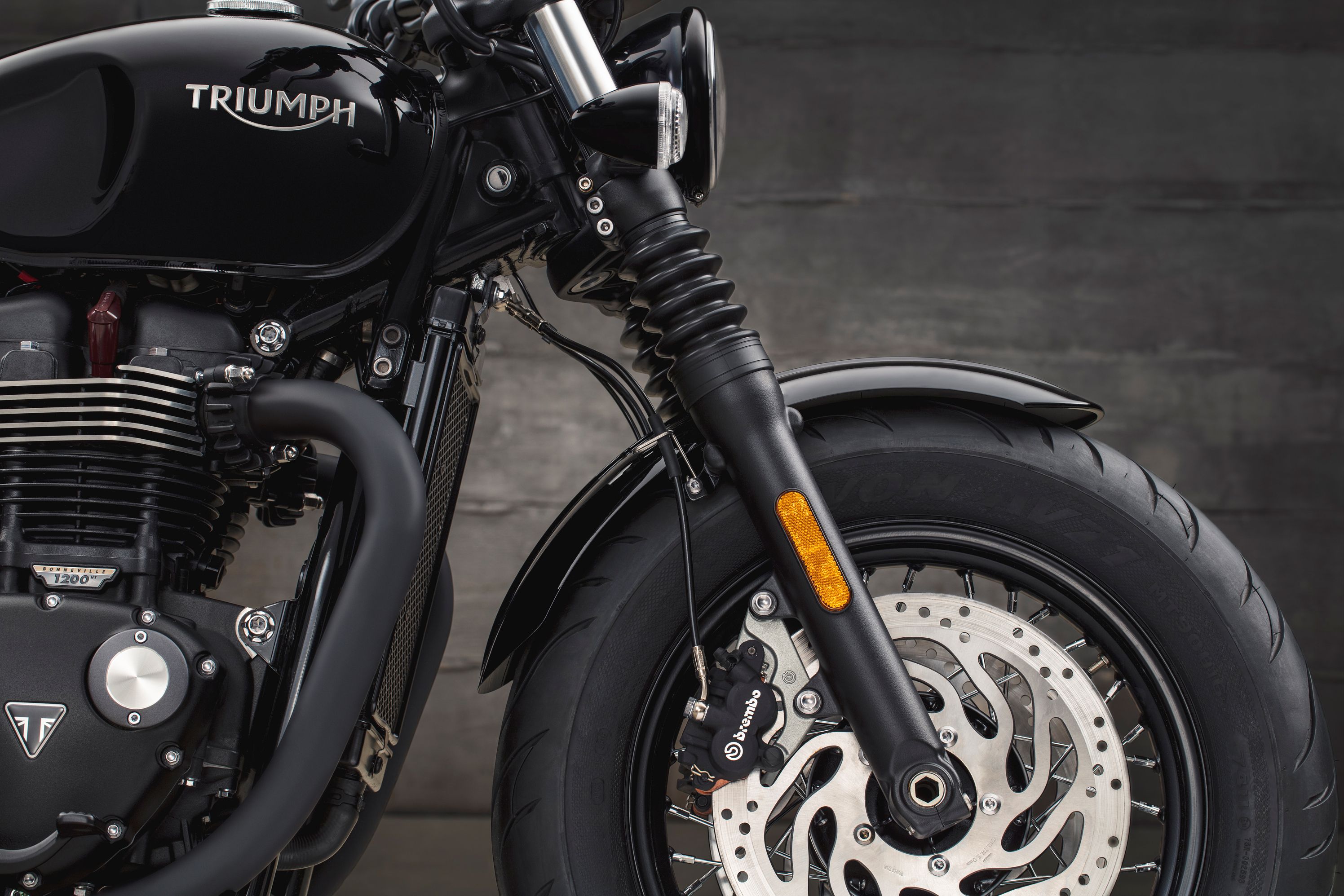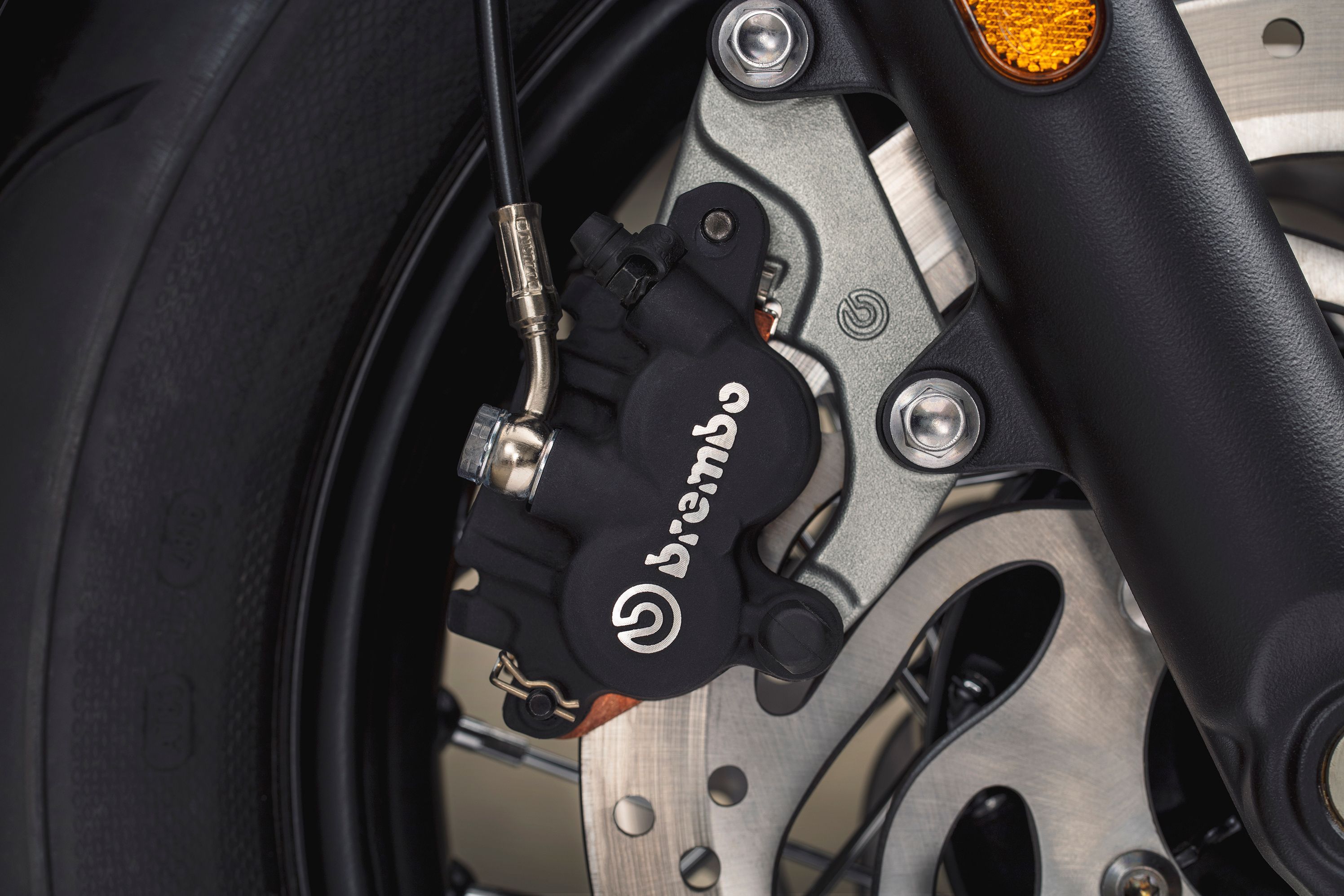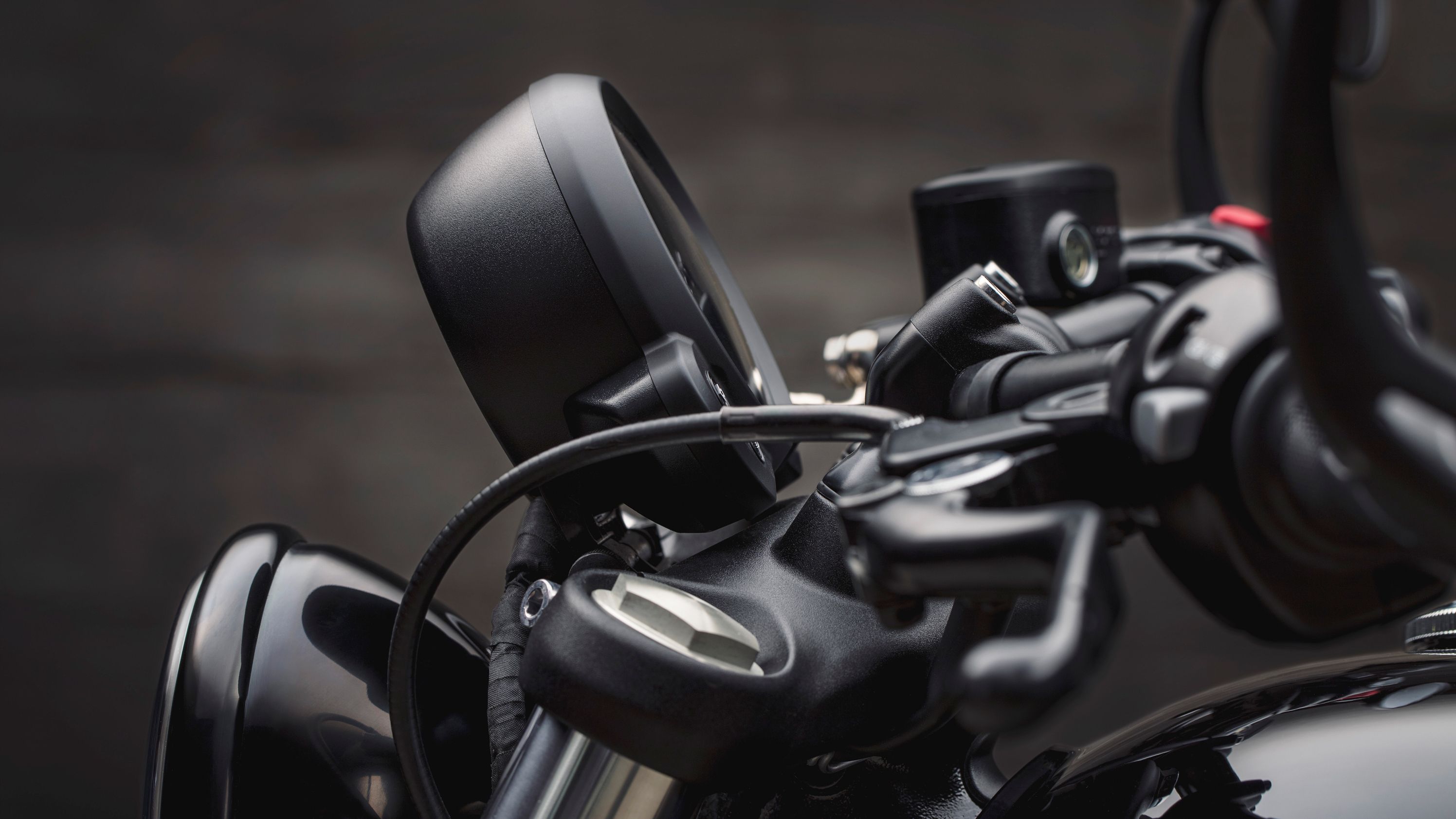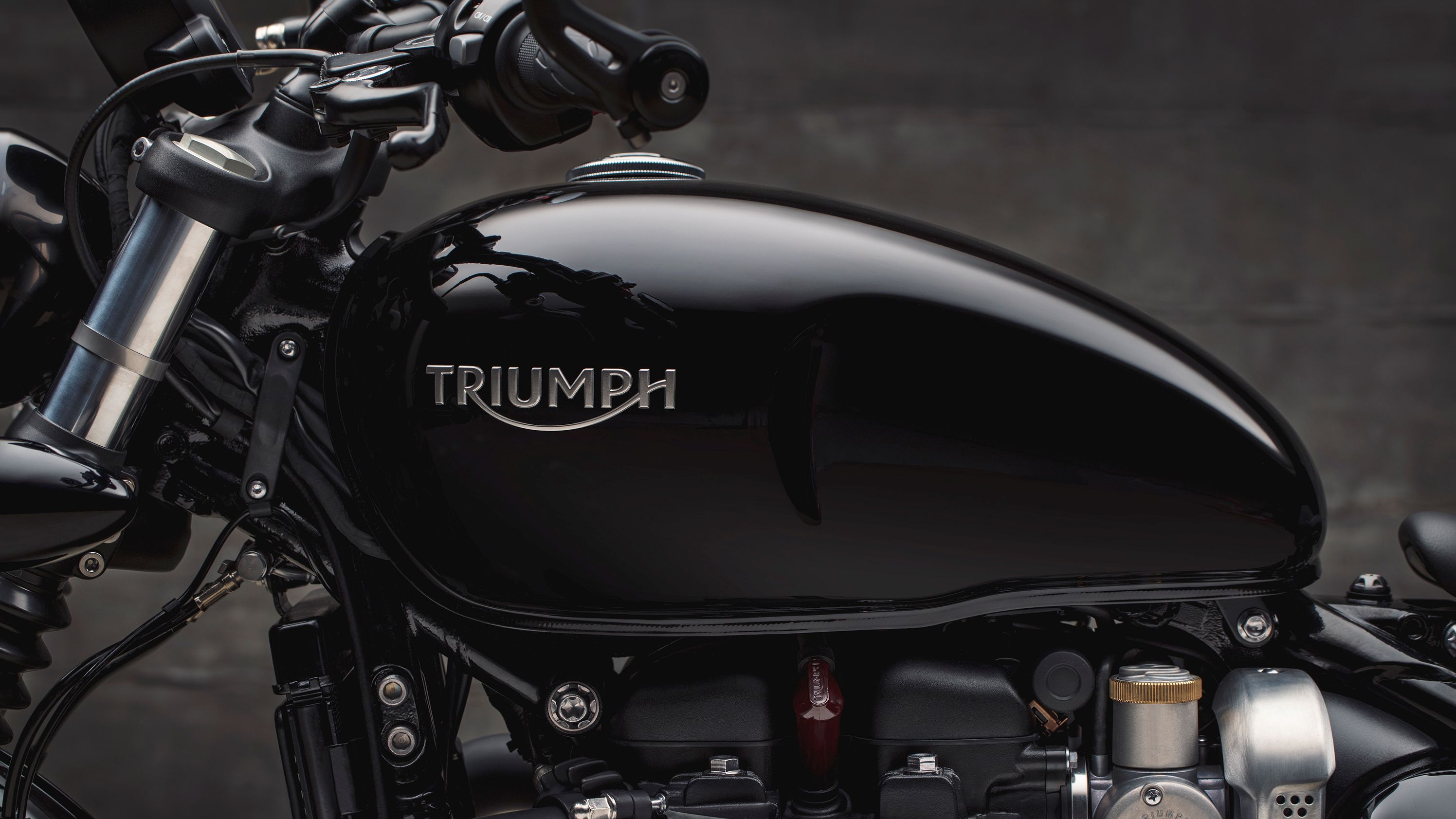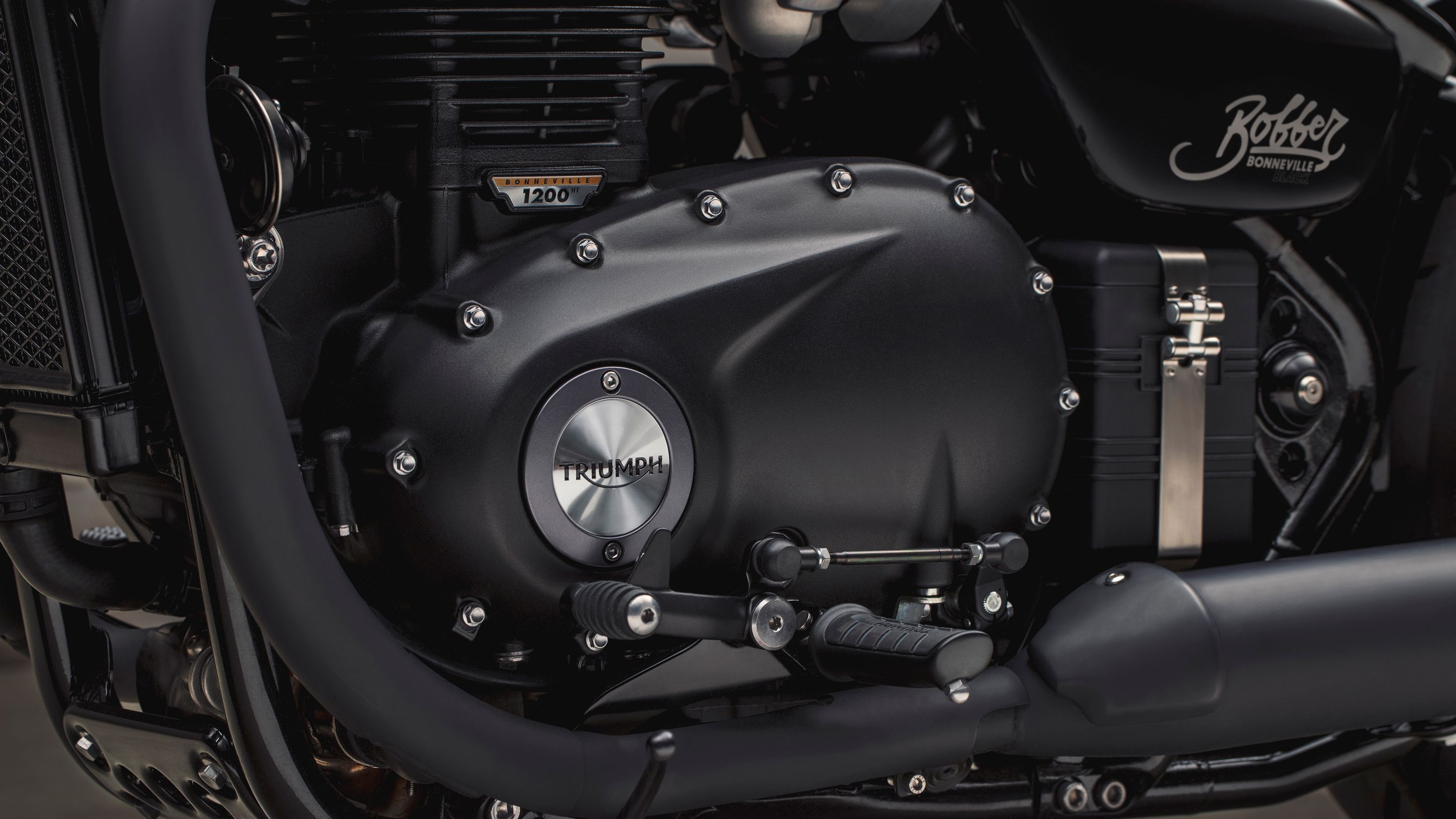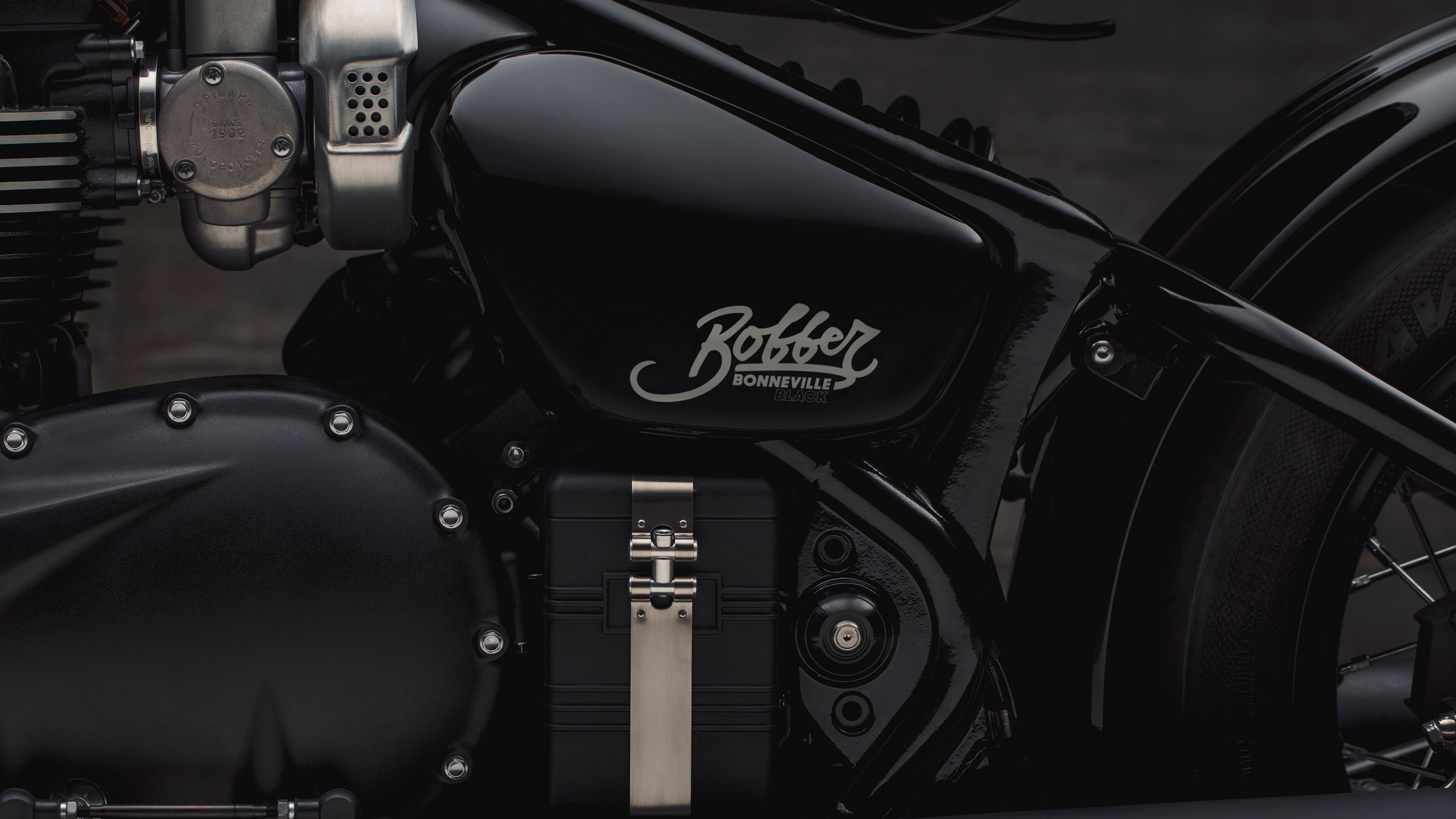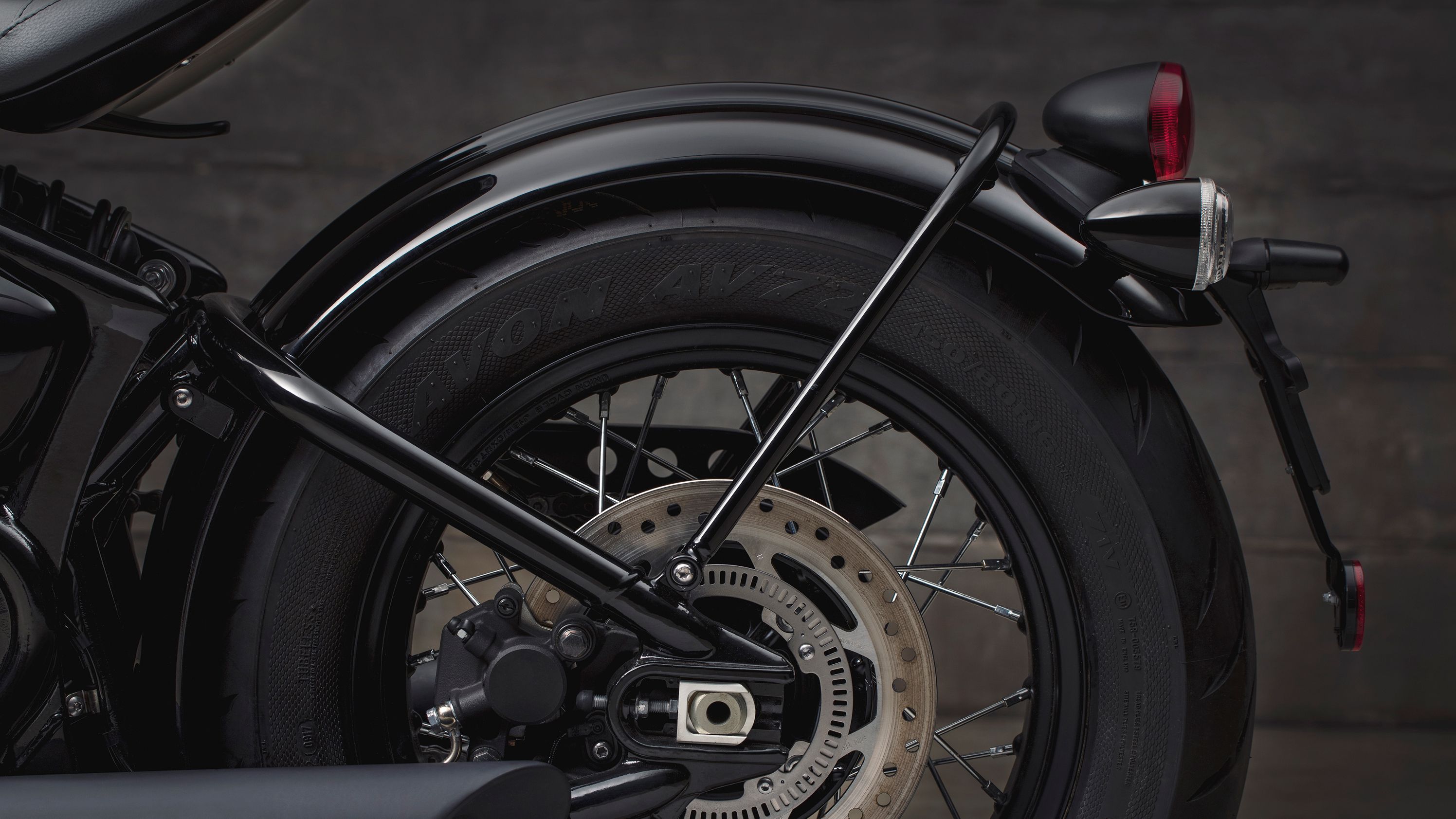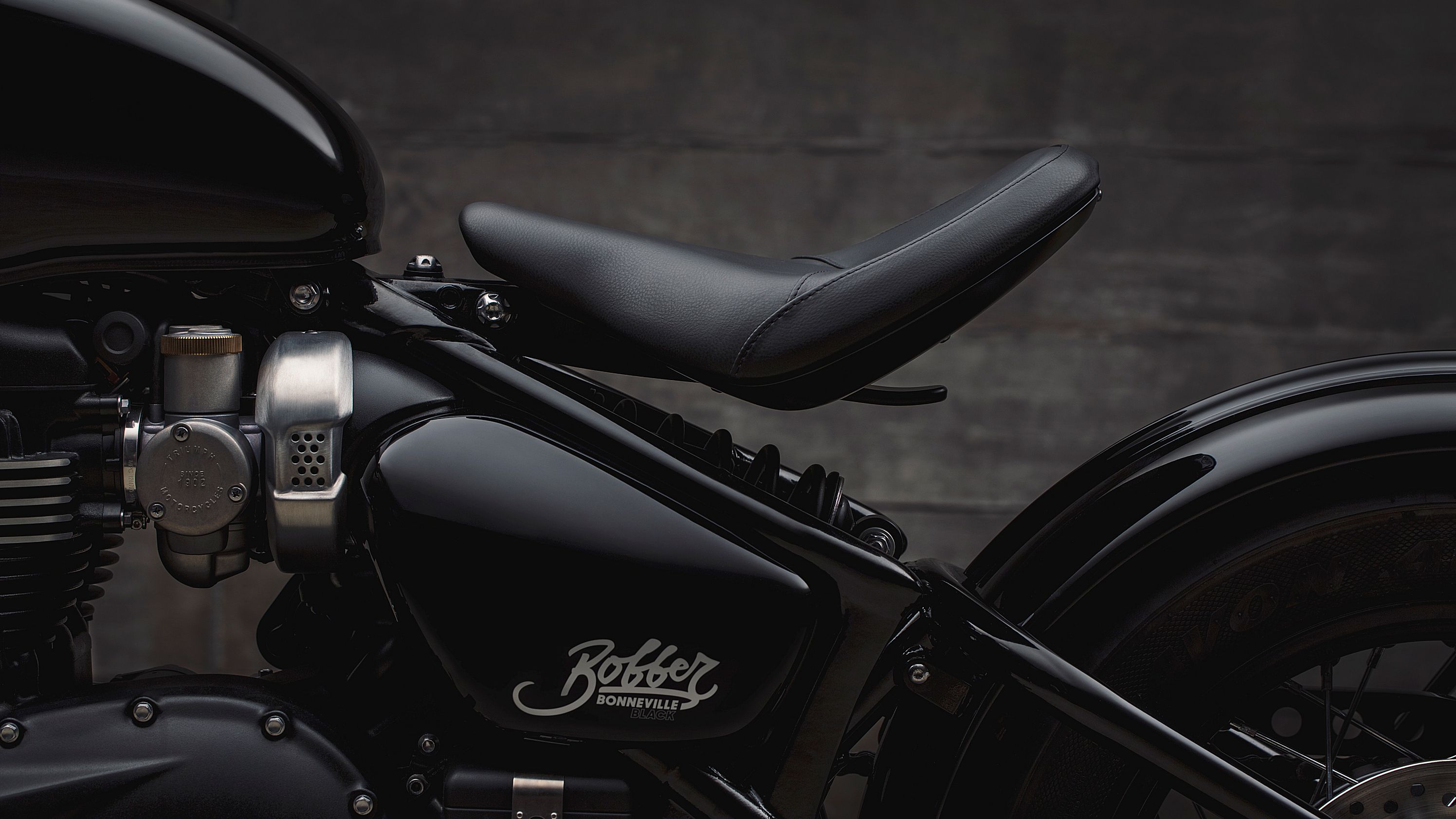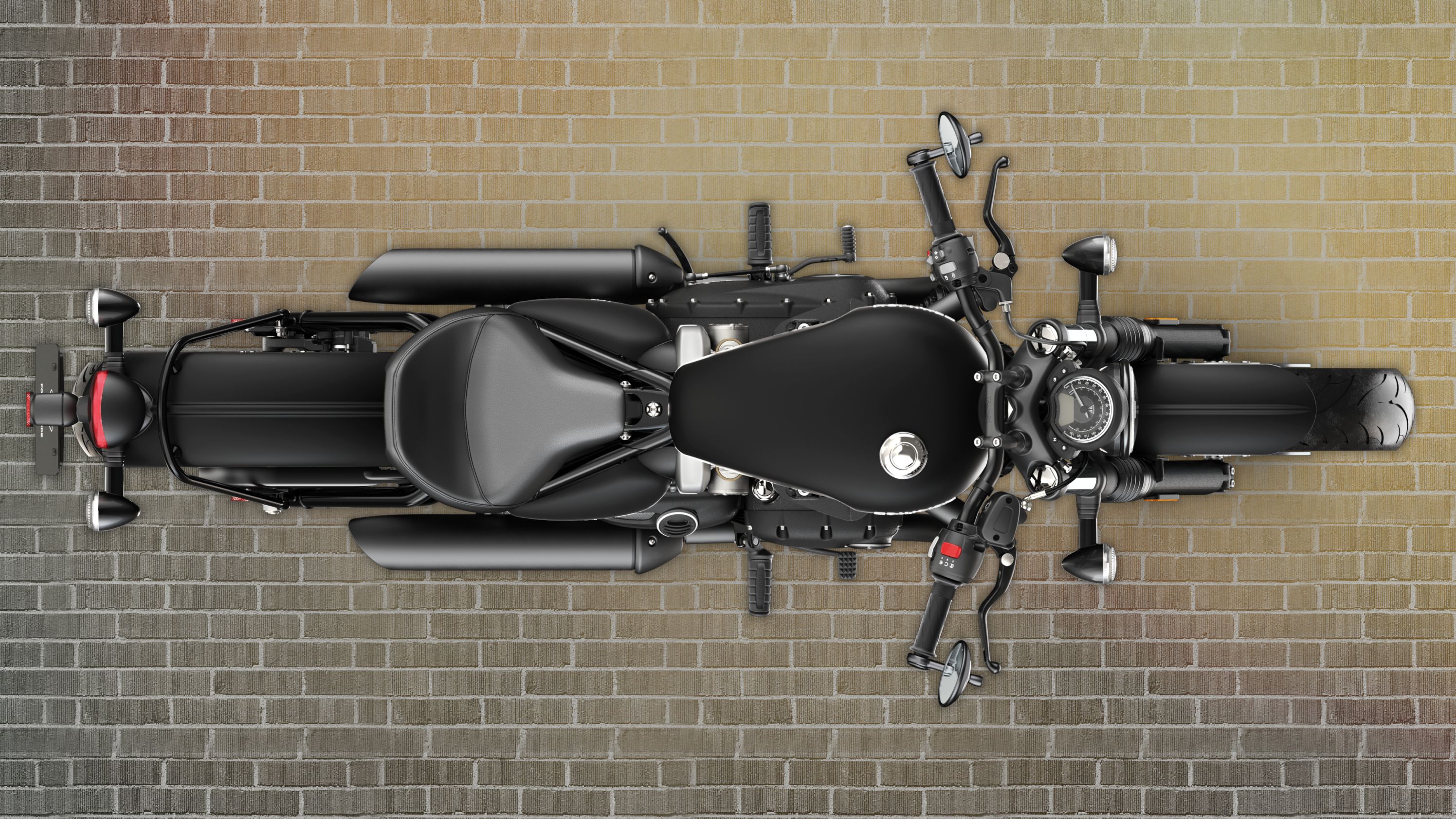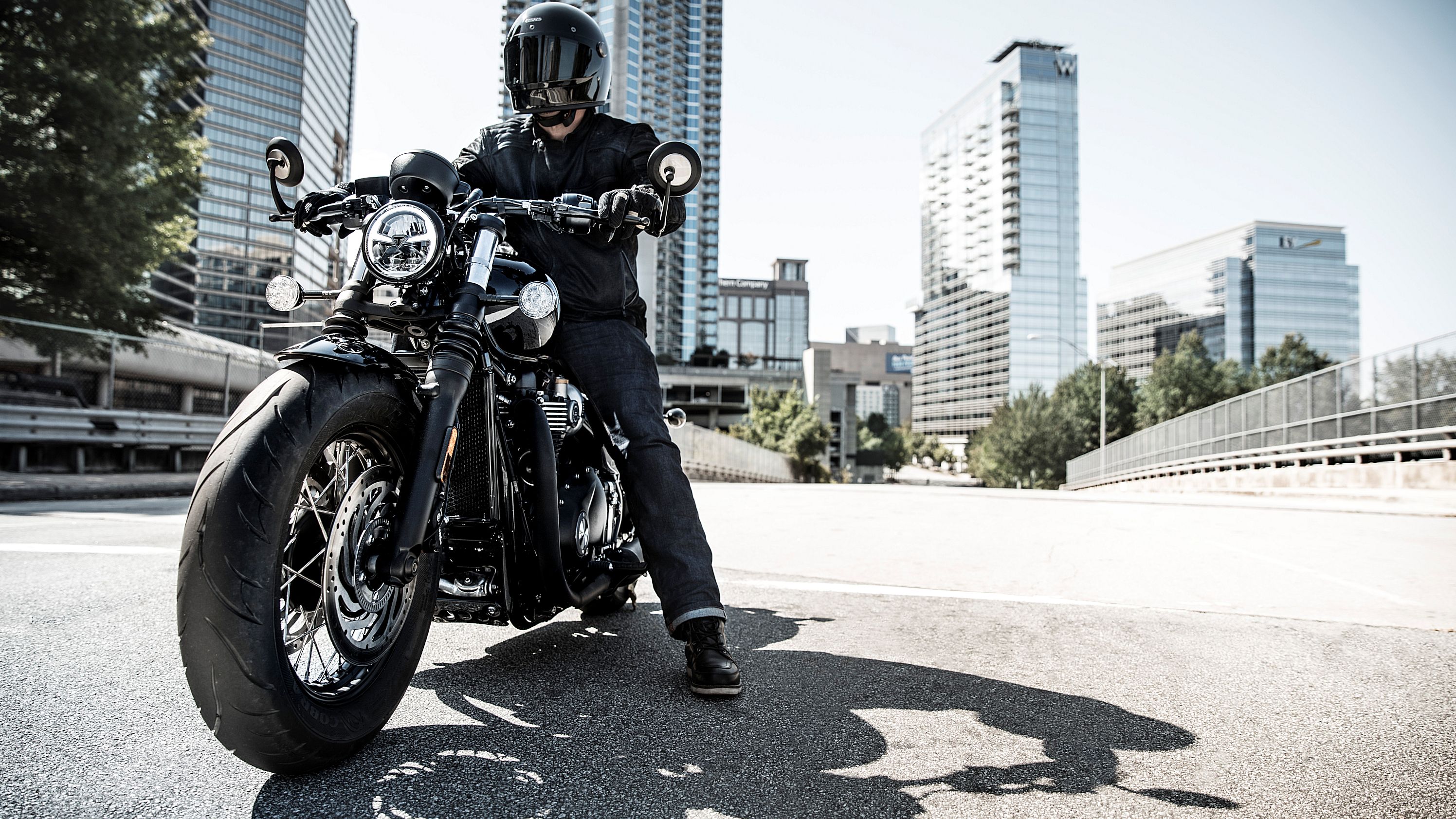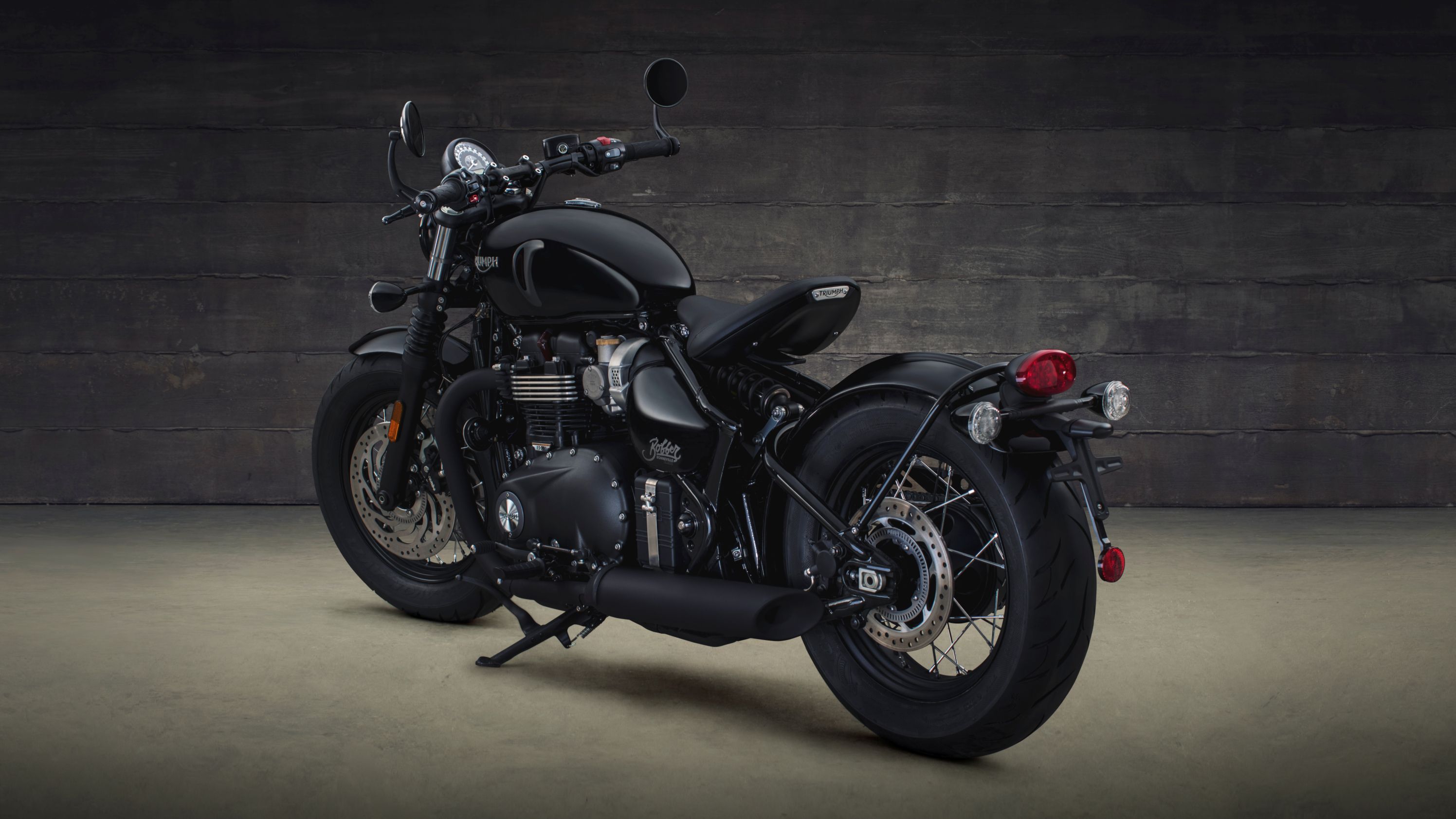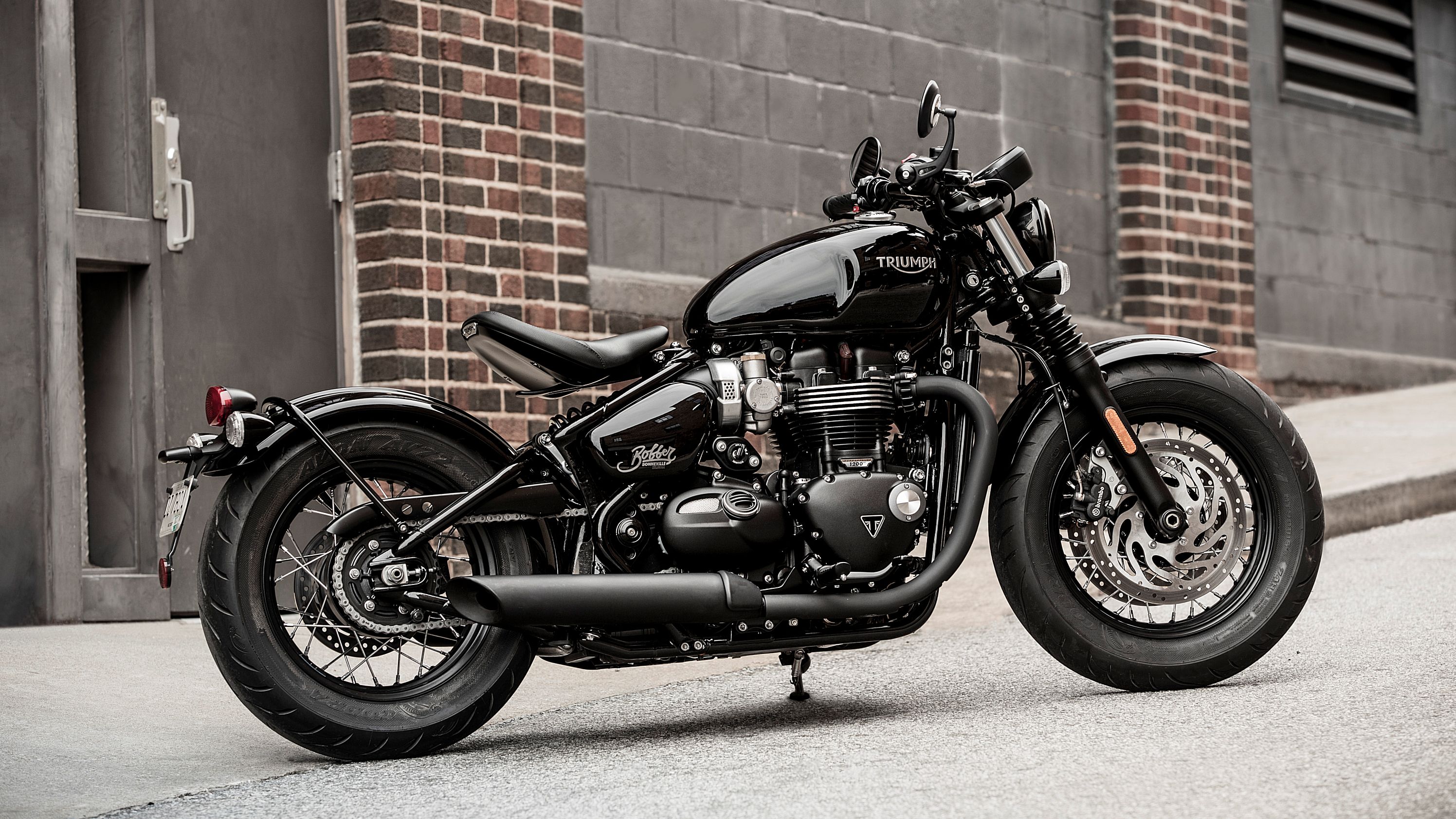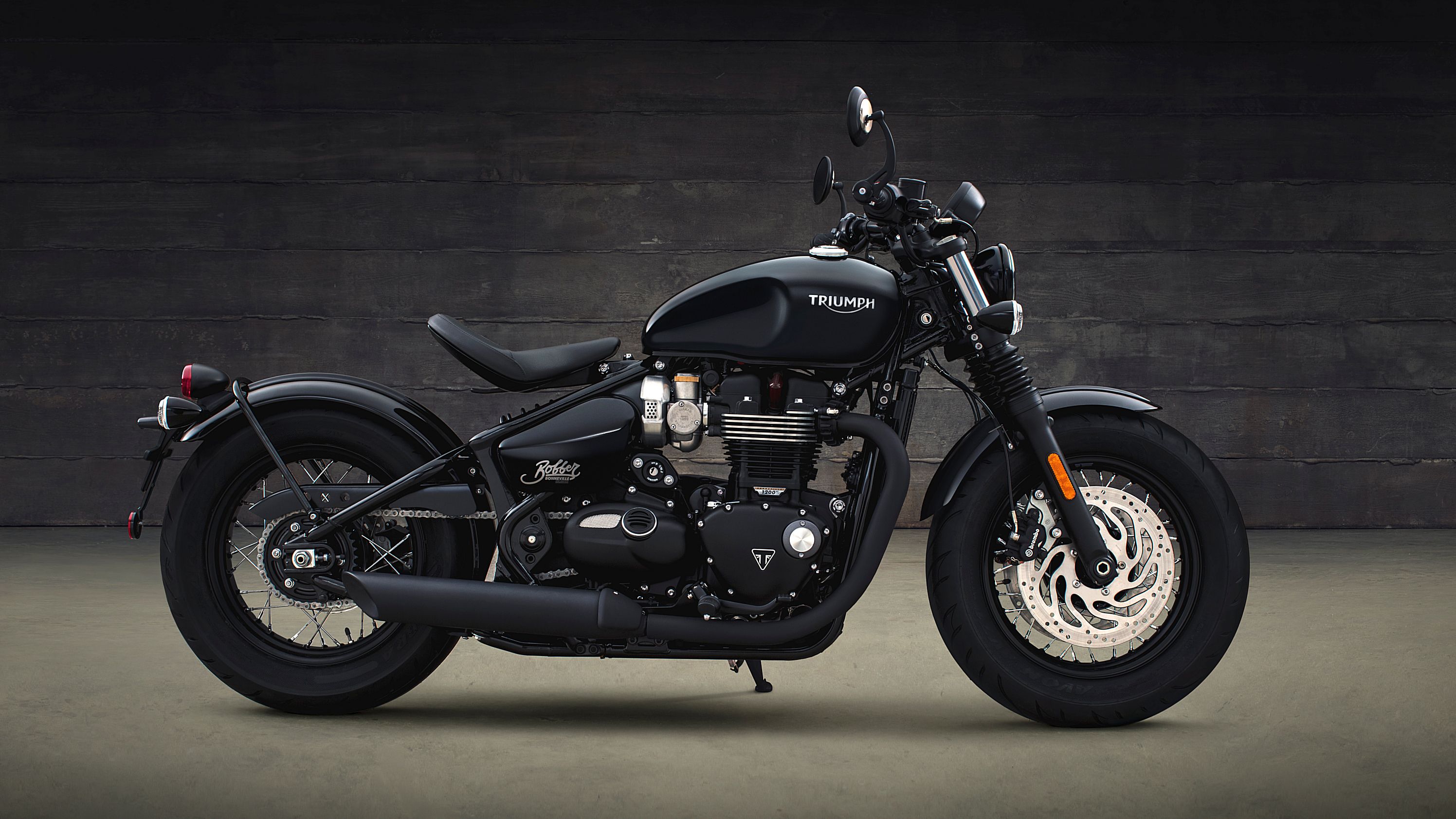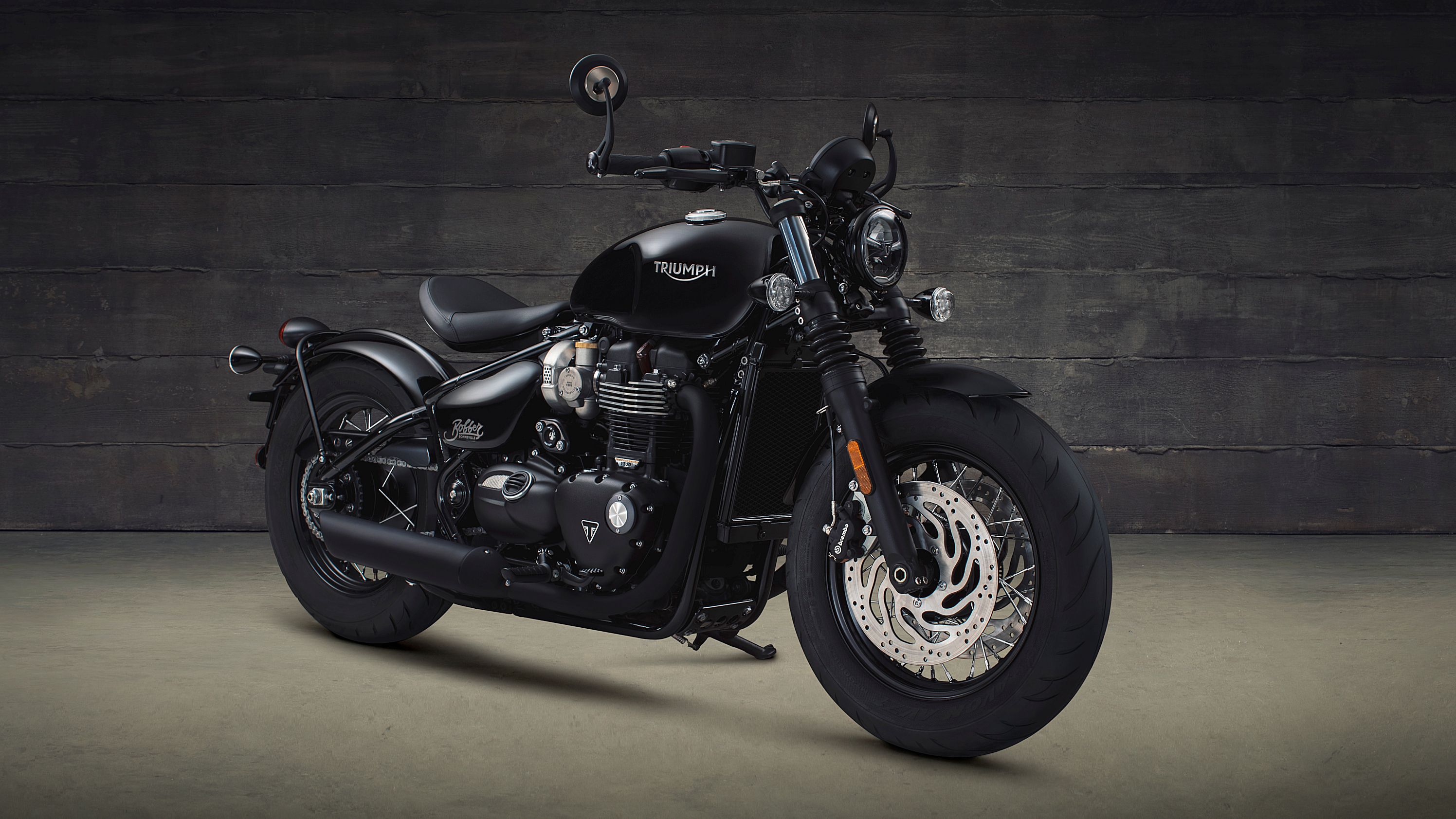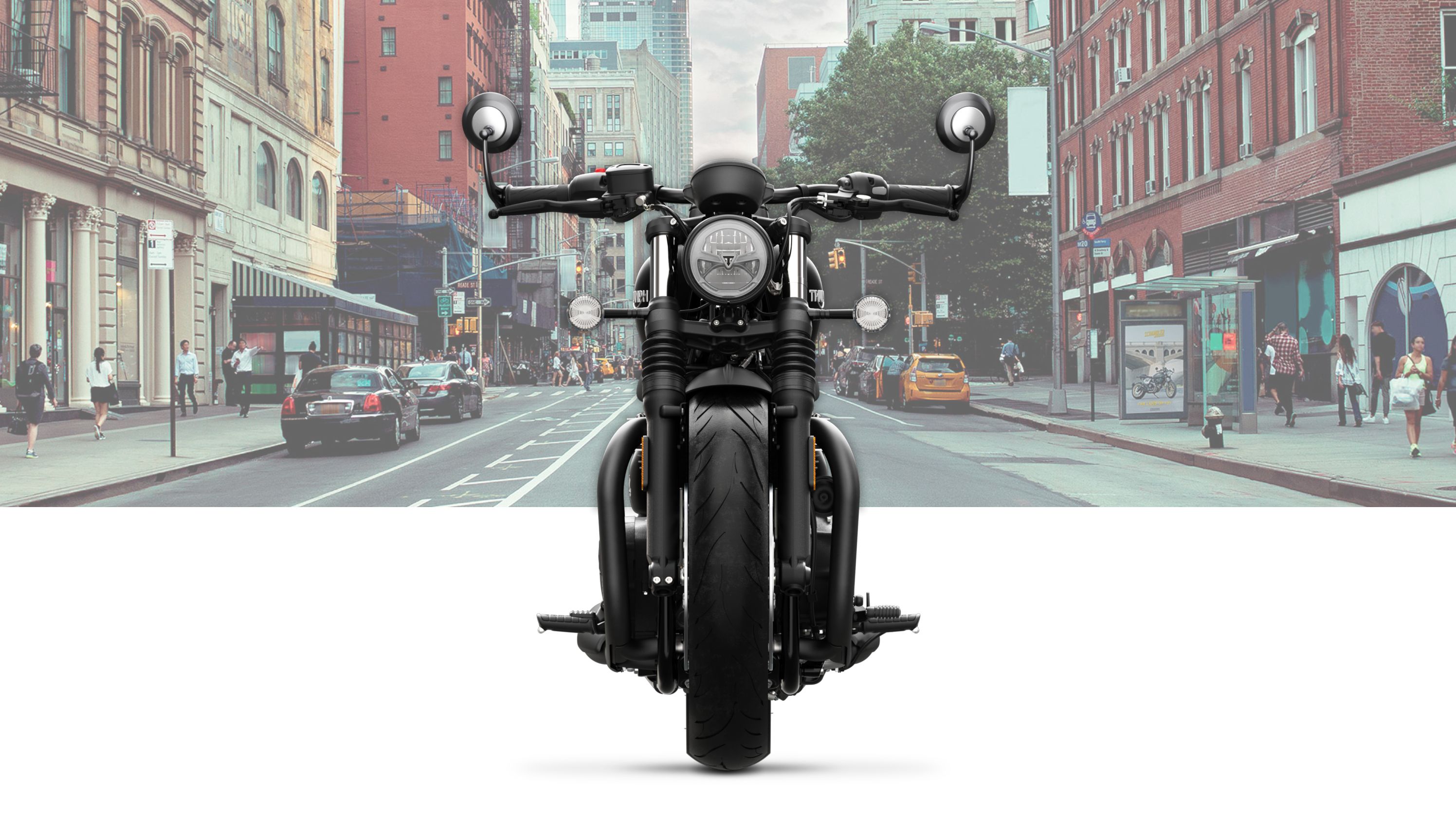Triumph expanded its record-setting Bonneville Bobber range last year with the new-in-2018 Bonneville Bobber Black. The “Black” builds on that success with more of the same stuff that made it a hit in the first place and some custom touches that give it more of a home-spun look right off the showroom floor. Already a thoroughly modern ride, the factory brushed it up with more tech even as it embraced even more retro-tastic features for an interesting duality of development, if you will. The Bonnie Twin mill delivers its 77 horsepower with the same characteristic 'tude we expect.
2018 - 2019 Triumph Bonneville Bobber Black
- Make: Array
- Model: 2018 - 2019 Triumph Bonneville Bobber Black
- Segment: Array
- Engine/Motor: Parallel-Twin
- [do not use] Vehicle Model: Array
Triumph Bonneville Bobber Black Design
If I had to sum up my feelings as succinctly as possible, I'd say the Bobbers in general are attractive bikes, but the Black is pure sex on two wheels. I'm apparently not alone in that, evidenced by the fact that the original Bobber was Triumph's fastest-selling bike. Ever. Consider the factory's 115-year history and let that sink in a moment. Suitably impressed? Yeah, I was too.
It's all about that retro vibe, y'all. The special “swing cage” frame that mimics the lines and geometry of the old hardtails is the main actor here, but it is the supporting cast that really sells it. Down from 19-inches on the base Bobber, a 16-inch front hoop adds a bit of symmetry that also lends some more visual weight down low with a custom kick. As the ingeniously-clever name suggests, the factory graced the Black with an abundance of blackout that literally runs from laced rim-to-laced rim. In fact, it would be easier to tell you what isn't rocking the dark finish: fork tubes, throttle bodies and brake discs, plus a handful of bits and bobs.
Fatter front forks beef up the front end with bellow gaiters that bulk it up even more, in spite of the fact that black can be very slimming. Bar-end mirrors and a low-rise bar help keep the control area clean behind the blackout LED headlight can (complete with DRL) and single instrument clock, but it's the 2.4-gallon teardrop tank and solo seat sticking out into empty space that defines the flylines with a crisp, even austere finish. The void beneath the saddle and the hoop-style rear fender sort of hides the rear shock in plain view to preserve that rigid rear-end illusion.
Bullet turn-signal housings join the blackout tail lamp to finish out the rear lights, and while it looks fine as-is, I gotta say it just screams out for a good old tombstone brake light. Even the rear hub throws off a drum-brake vibe to the right side, but thankfully like the rear end, it's just another illusion. Short, compact and cut down, the Black has an all-up-front look that I really like with an unmistakable British-ness that seems both dignified and a little bit “wild man” all at the same time.
Triumph Bonneville Bobber Black Chassis
As with any bike, the overall look has many determining factors, but it's the special frame that really does the trick here. Similar to Harley-Davidson's Softail skeleton, the Bobber runs with an articulated, triangular swingarm that mimics the look of the old rigids while delivering a modern ride thanks to the coil-over shock under the seat. Tubular-steel members make up the double-downtube/double-cradle frame with a 25.4-degree rake and 3.6 inches of trail on a 59-inch wheelbase that gives the Bobber its agile handling characteristics. That's right sports fans; in spite of its old-school looks, the Bobber delivers an exciting ride, which makes sense 'cause the original bobbers were all about performance, after all.
Seat height is slammed to the max at only 27 inches off the deck which is great for the vertically-challenged as well as the rest of us as it contributes to nimble handling by keeping the center of gravity nice and low. Fork-tube diameter got boosted from 41 mm up to 47 mm, and they run in the traditional right-way-up configuration, but the Showa struts come with fixed damping values and no adjustments whatever. Marginally disappointing, but not at all surprising.
In the back, the coil-over, KYB shock has the obligatory variable preload, but nothing else. At 524 pounds dry, the Bobber isn't a particularly heavy bike, but Triumph loaded it for bear with dual 310 mm discs up front and a 255 mm disc out back. Brembo calipers bind the front, and Nissin the rear, all under the watchful eye of the standard ABS feature that serves as the first line of protection for your contact patches, but certainly not the last.
|
Frame: |
Tubular steel cradle |
|
Swingarm: |
Twin-sided, tubular steel |
|
Front Suspension: |
Showa 47 mm forks with cartridge damping, 90 mm travel. |
|
Rear Suspension: |
KYB monoshock with linkage, 77 mm travel |
|
Front Wheel: |
32-spoke, 16 x 2.5in |
|
Rear Wheel: |
32-spoke, 16 x 3.5in |
|
Front Tire: |
130/90 B16 |
|
Rear Tire: |
150/80 R16 |
|
Brakes, Front: |
Twin 310 mm disc, Brembo 2-piston floating calipers, ABS |
|
Brakes, Rear: |
Single 255 mm disc, Nissin single piston floating caliper, ABS |
Triumph Bonneville Bobber Black Drivetrain
As with everything else on this ride, the engine itself exudes that British vibe by virtue of its vertical-twin configuration, intake/exhaust arrangement and stylized case covers. Bless their hearts, the engineers even went to great lengths to make the throttle bodies look like the old mechanical-slide carburetors, and it is this attention to detail that makes the Bobber such an attractive machine even if you are unfamiliar with the history of the brand.
A 97.6 mm bore and 80 mm stroke gives the mill its 1,200 cc displacement. The compression ratio lands on the cooler end of the spectrum at 10-to-1 which is still enough to put you at the mid-grade pump even if it gives the bottom end a break and helps limit waste-heat generation. Said heat vents to the atmosphere via the downtube mounted radiator, and it's worth mentioning that we get to see another aesthetic benefit from the blackout treatment as the rad all but disappears against all that achromatic paint. Yeah, it's liquid cooled, but it doesn't look like it at a casual glance.
Power numbers reveal a sporty personality that gives lie to the outdated look of the bike. A total of 78 pounds o' grunt come on at 4,000 rpm with 77 ponies that develop fully by 6,100 rpm so there's plenty of power to work with, and you don't have to wind it up tighter than Dick's hatband to get at it. A ride-by-wire throttle controls the induction, but it ain't alone as the Riding Modes feature tailors power delivery according to demand so you can de-tune a bit for safety in dodgy conditions with poor traction. If that isn't enough, the Traction Control monitors wheel slip and intervenes to preserve contact-patch integrity for the third safety net for riders whose ambition is greater than the available traction.
Power flows through a six-speed transmixxer and tough chain final drive, but the clutch itself provides the fourth layer of protection with a slip-and-assist function that limits backtorque in the system and the problems associated with aggressive downshifts and engine braking. That's right, Triumph wants to make sure you get there in spite of yourself. Someone who loves you will appreciate that.
|
Engine: |
Liquid cooled, 8 valve, SOHC, 270° crank angle parallel twin |
|
Displacement: |
1,200 cc |
|
Bore Stroke: |
97.6 / 80mm |
|
Compression: |
10.0:1 |
|
Max Power EC: |
77 hp (57kW) @ 6,100 rpm |
|
Max Torque EC: |
78 ft-lbs (106Nm) @ 4,000 rpm |
|
System: |
Multipoint sequential electronic fuel injection |
|
Exhaust: |
Brushed stainless steel 2 into 2 twin-skin exhaust system with brushed stainless silencers |
|
Final drive: |
Chain |
|
Clutch: |
Wet, multi-plate assist clutch |
|
Gearbox: |
6-speed |
Triumph Bonneville Bobber Black Pricing
You can score one of the 2019 Bonneville Bobber Black models in a glossy Jet Black finish for $13,150 or opt for the even more ominous looking Matte Jet Black for $13,400. So, much like the old Fords, you can have any color you want as long as you want black.
|
Colors: |
Jet Black, Matte Jet Black |
|
Price: |
$13,150 (Matte Jet Black: $13,400) |
Triumph Bonneville Bobber Black Competitors
|
|
left> 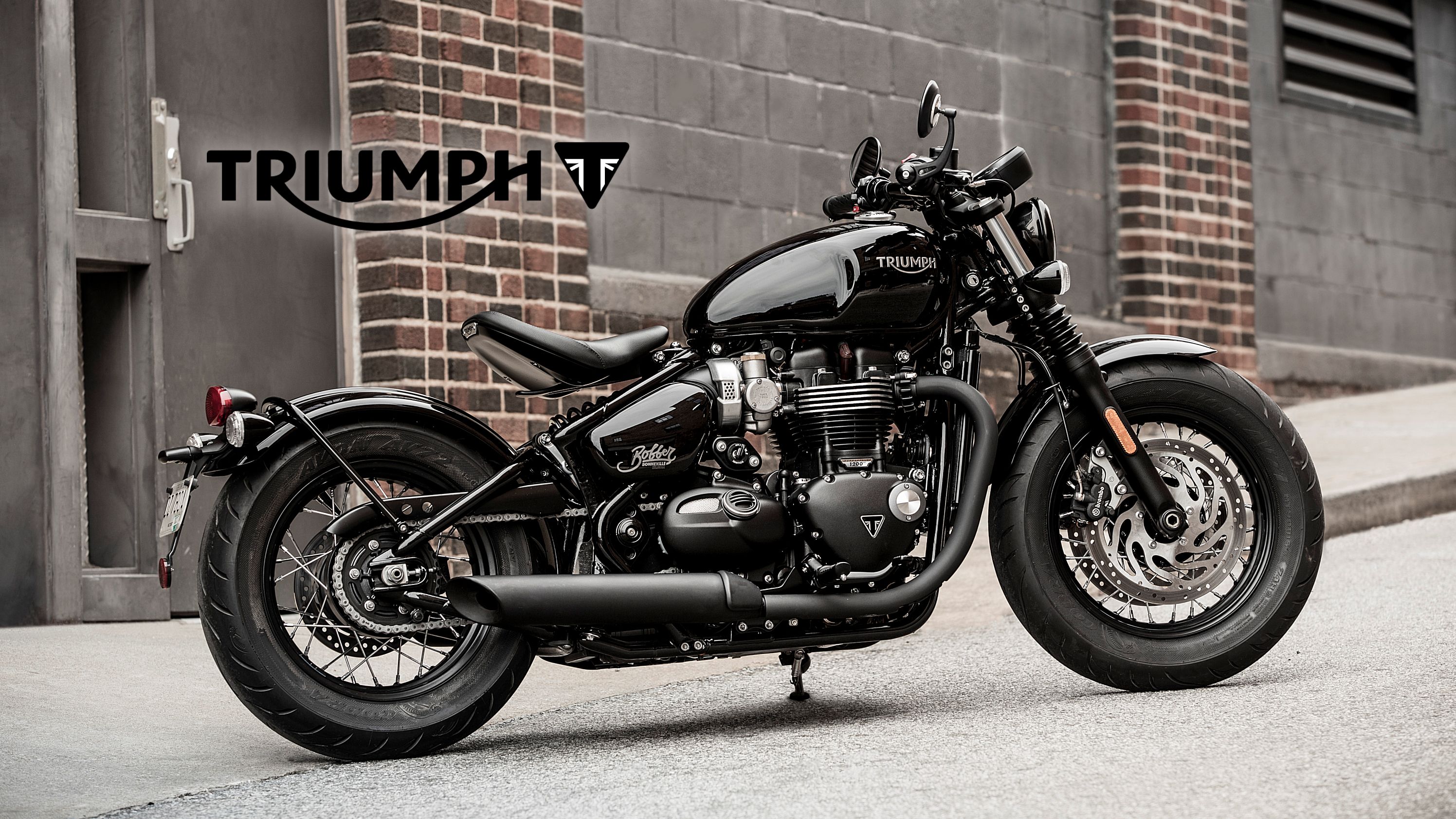
|
While fake-hardtail frames are becoming more common, they are still quite niche and liable to appeal to a relatively-narrow subset of riders. Having said that, I've been saying for years that Harley-Davidson needed to stick a 1,200 cc Sportster mill into a slightly smaller version of its Big-Twin powered Softail line, but the MoCo didn't exactly call me to ask my opinion and Triumph has beaten them to the punch. Since the vast majority of H-D riders also have an appreciation for machines from our cousins across the pond, I thought it fair to pit the Harley-Davidson Roadster against the Bobber to see how it all shakes out. This is what I found.
Though not named as such, the Roadster is effectively a bobber as well with fenders that are cut down to the absolute quick and a short handlebar that pulls the rider into an aggressive riding posture. The blackout is strong with this one with but a few more bits of bling than one finds on the Brit, but it sports a similar, somewhat-sinister panache. Harley beefs up the front end not with fat forks and gaiters, but with inverted stems that lend it a sportiness (no pun) all its own; though it, too, falls short with no adjustments available in the suspension beyond the preload on the rear shocks. As much as I love my Sportsters, I have to admit that Trumpet beats the pants off Harley this time, no doubt about it.
Displacement and performance are neck and neck with a total of 76 pound-feet of torque from the Roadster's V-twin plant, which is all good and fine but doesn't tell the whole story. Triumph alone embraces the fandanglery with the traction control and variable power delivery features that we still aren't seeing from H-D. This is a problem since the Millennials -- that manufacturers are scrambling to attract -- are all digital natives with an expectation of high-tech yummy goodness, and I fear every year H-D lags behind is just another nail in the coffin.
It doesn't happen often, but Harley wins at the checkout with a price range that swings from $11,299 through $11,649, depending on color. ABS is available, but will set you back another eight Benjamins, and the security system is another four bills which brings the price right on up against that of the Bobber Black. In other words, the lower price is actually a false economy.
He Said
“I don't even mind saying that I'd pick the Bobber Black over any bobber/roadster-style ride in the world right now. Brand loyalty will only carry you so far, and Trumpet has thoroughly seduced me with the Bobber line. Good looks, exciting performance and an undeniable pedigree are the hallmarks of the family line, and I, for one, can't get enough of it. Too bad my wife would likely knife me in my sleep if I were to come home with one...”
She Said
My wife and fellow motorcycle writer, Allyn Hinton, says, “Knife you? Hardly, but let's not tempt fate. We already did the 'It's only a test drive. . . no really, just a test drive....I love you' on the Bobber visit. Let's not do it again on the Bobber Black. This new Black isn't just a blacked-out Bobber. It really is its own entity. With an upgraded front end and solid brakes (that you can squeeze just as hard as your hand can manage because of the ABS), the Bobber Black is a cut above the basic Bobber. The Speedmaster Twin engine is very torquey low down, the ride is smooth and gutsy, and even though it isn't a sportbike, the suspension feels rather firm and sportbike-like. All that said, I think this is a really sexy-looking bike.”
Triumph Bonneville Bobber Black Specifications
|
Engine & Drivetrain: |
|
|
Engine: |
Liquid cooled, 8 valve, SOHC, 270° crank angle parallel twin |
|
Displacement: |
1,200 cc |
|
Bore Stroke: |
97.6 / 80 mm |
|
Compression: |
10.0:1 |
|
Max Power EC: |
77 hp (57kW) @ 6,100 rpm |
|
Max Torque EC: |
78 lb-ft (106Nm) @ 4,000 rpm |
|
System: |
Multipoint sequential electronic fuel injection |
|
Exhaust: |
Brushed stainless steel 2 into 2 twin-skin exhaust system with brushed stainless silencers |
|
Final drive: |
Chain |
|
Clutch: |
Wet, multi-plate assist clutch |
|
Gearbox: |
6-speed |
|
Chassis: |
|
|
Frame: |
Tubular steel cradle |
|
Swingarm: |
Twin-sided, tubular steel |
|
Front Wheel: |
32-spoke, 16 x 2.5in |
|
Rear Wheel: |
32-spoke, 16 x 3.5in |
|
Front Tire: |
130/90 B16 |
|
Rear Tire: |
150/80 R16 |
|
Front Suspension: |
Showa 47 mm forks with cartridge damping, 90 mm travel. |
|
Rear Suspension: |
KYB monoshock with linkage, 77 mm travel |
|
Brakes, Front: |
Twin 310 mm disc, Brembo 2-piston floating calipers, ABS |
|
Brakes, Rear: |
Single 255 mm disc, Nissin single piston floating caliper, ABS |
|
Instrument Display and Functions: |
LCD multi-functional instrument pack with analogue speedometer, odometer, gear position indicator, fuel gauge, range to empty indication, service indicator, clock, 2x trip, average & current fuel consumption display, traction control status display, heated grip ready - controlled by a handlebar mounted scroll button. |
|
Dimensions & Capacities: |
|
|
Width Handlebars: |
30 in (760 mm) |
|
Height Without Mirror: |
40 in (1,025mm) |
|
Seat Height: |
27 in (690 mm) |
|
Wheelbase: |
59 in (1,510 mm) |
|
Rake: |
25.4º |
|
Trail: |
3.6 in (92 mm) |
|
Dry Weight: |
524 lb (237.5kg) |
|
Tank Capacity: |
2.4 US gal |
|
Top Speed: |
93 mph (est) |
|
Details: |
|
|
Fuel Consumption: |
Fuel consumption: 54.1 US mpg |
|
Colors: |
Jet Black, Matte Jet Black |
|
Price: |
$13,150 (Matte Jet Black: $13,400) |
Further Reading
Harley-Davidson Roadster
|
|
center> |
See our review of the Harley-Davidson Roadster.
Triumph Bonneville Bobber
|
|
center> |
See our review of the Triumph Bonneville Bobber.
Triumph
Read more Triumph news.


